
Canadian vs. American college sports programs
By Radhya Comar, October 27 2022—
Canadians and Americans definitely have their fair share of differences. Some are tiny and inconsequential such as the colour of currency or the spelling of colour itself, while others are vast and confusing. The differences between college sports in Canada and the United States falls into the latter category.
Many of these differences can be attributed to the vast disparity between media coverage on college sports in Canada and the US. Media coverage plays a huge role in the popularity of college sports as it allows people across the country to engage with the sports. ESPN, the most popular sports network in the US, pays an average of $34 million USD a year to broadcast collegiate championships in a number of sports. This deal between ESPN and the National Collegiate Athletics Association (NCAA) was signed in 2011 and is slated to expire at the end of the 2023-2024 season of sports. In comparison, U Sports, which oversees university-level sports in Canada, signed their most influential deal in 2021. The association signed a four-year deal with CBC to broadcast championships in all sports.
However, the question as to why American college sports receive more media coverage still remains. The answer could lie simply in cultural differences between the two nations. Maybe Americans just pay more attention to athletics in general. After all, their culture can be easily identified with many different sports. In professional basketball, the majority majority of the NBA is made up of American teams with American players. The same could be said for football and baseball which have strong cultural ties around the country. These diverse interests in sports in America directly translate to more popularity for their college athletics programs. Having a wide range of broadcasted sports allows citizens to get engaged with whichever one they prefer. Yet, in the sports aspect, Canadian media is dominated by ice hockey. This prompts the average Canadian to turn away from the television if the broadcasted sport isn’t hockey — whether its at the professional or collegiate level.
When discussing this topic, many consider the elephant in the room to be the differing skill levels of college athletes in the two countries. This is not a commentary on the players themselves but the different environments they are trained in. For example, it was found in 2018 that the average Division 1 football program in America had an annual budget of $22 million USD. This statistic was averaged from the budgets of 15 FSB institutions. Alabama State University topped this list with an annual average of $60 million USD spent on the football program. Sitting at the bottom, the University of Miami had an average annual budget of $36 million USD. Comparatively, in the 2017-2018 fiscal year, the University of Ottawa had an overall athletics budget of $16 million, which is about $11 million USD, adjusted for inflation. This budget includes costs for facilities, staff and operations.
In general, the sports budget directly impacts the experience of an athlete. The amount of funding determines the available scholarships and bursaries available for student athletes. It also influences the quality and quantity of staff hired. These roles include coaches, trainers and medical personnel. Overall, these differences in funding display the increased importance placed on sports in American schools when compared to their Canadian counterparts.
Differences in media coverage, general sports culture and funding are all factors that can indicate why Canadian college sports pale in comparison to our American neighbours. In reality, however, they are just the first couple of factors that cross the mind. Differences in population, the varying quality scholarships and academic lenience are factors that are often overlooked. Although at the moment, it is safe to say that athletics in Canadian universities will look the same for the near future. Even though college sports are starting to be integrated in mainstream media, cultural and monetary changes just seem too radical at this point in time.
